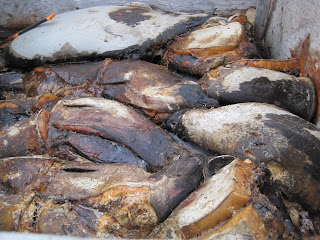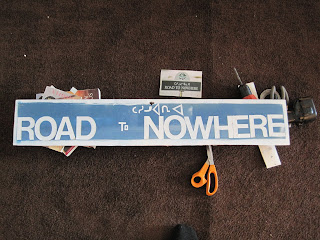Last week, I found a little store called "Iqaluit Enterprises Ltd.: Smoked Arctic Char and Northern Seafoods." It's a store that sells seal, Arctic char and whatever other seafood that the fishermen up island catch.They had char steaks and fillets, hunks of seal and whole char. Josh and I thought it would be fun to buy a fish and make something with it! Thanks to the Iqaluit Recipe swap, we found a delicious recipe for Arctic Char Chowder and Oven Baked Bannock. Gutting, deboning and skinning that fish was an adventure in itself, since all the knives we have are dull. It looked like a massacre! But in the end, we had a delicious chowder simmering on the stove while bannock baked in the oven. Yum! Darlene and Tracy (nurses I work with) were brave enough to come over and enjoy it with us. And yes, the meal did start with the disclaimer, "We think we have removed all the bones, but in case we missed one and you choke, we're all medical professionals at this table....and we'll save you."
 |
| Fish thawing in the tub ("...all drains lead to the ocean" - Finding Nemo) |
 |
| This 23 inch char was the smallest one in the freezer, cost $35.88. |
 |
| Let the massacre begin! |
 |
| Char Chowder soup |
 |
| Bannock |
Recipes....
Anna Qaunaq's Char/Chowder Soup
1 arctic char
2 cans of mushroom campbell soup
milk
1 can of drained baby clams
2 medium potatoes
2 carrots* (optional)
2 tsp tobasco sauce
salt and pepper
cut up char into stakes and boil in salted water about 1/2 hour.
in the mean time, peel potatoes *carrots and dice.
take char out and remove skin and bones, put into a separate pot, add mushroom soup, stir to make fish into flakes, add 2 full cans of milk using mushroom soup cans and add 1 1/2 can or 2 cans of water, its at your discretion how thick you want your soup.
add potatoes, *carrots, drained baby clams, 2 tsp tobasco sauce, corn, salt and pepper
cook stove top at medium heat 1/2 to 45 minutes, or until the potatoes/*carrots are done.
Excellent with baked bannok.
Optional: you can add any type of seafood into pot and create your own arctic char seafood stew!
Ruth Kadlutsiak's Oven Baked Bannock
4 cups flour 2 tbsp. baking powder 1 tsp. salt 1 cup lard, melted 2 1/4 cups milk
1. Mix flour, baking powder and salt in a large mixing bowl.
2. In a small saucepan, melt lard. Pour 1/2 cup melted lard into a 9" square baking pan.
3. Pour milk into the remaining 1/2 cup lard in the saucepan. It will sizzle a little. Heat just until warm.
4. Pour lard and milk into flour mixture and stir quickly, just until blended.
5. Spread batter gently in the prepared pan. Dip your fingers in the melted lard to prevent the dough from sticking to you.
6. Bake at 450 F (230 C) fro 20-30 minutes. Turn out of pan and cut into squares to serve. Serve warm or cold.










































